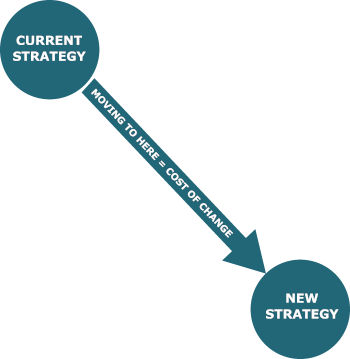Changing business strategy
There is a big difference between evolving an existing business strategy and changing it.
All existing strategies must evolve in order to survive.
Your chosen strategy should therefore be reviewed regularly.
This means you have to monitor variables so that your business strategy remains relevant to reality.
Changing strategy is a whole new ball game.

Two situations where business strategy has to evolve
1. If your strategy is not working
If your strategy is not working then you have to pinpoint the small or big, few or many variables that require attention, influence and change.
You may have miscalculated a variable or was not aware of its existence when initially undertaking the feasibility and planning of your strategy,
When such anomalies come to your attention then you have to take action to get things back on track.
Sometimes there will be delays and additional costs. At other times there may be opportunities.
2. When the strategy is proving successful
Even successful strategies require evolution.
For example, when you start making good money is when the wolves smell the meat and come after you.
You have to evolve to beat them off: to keep ahead. You at least need a flaming stick to wave them off until they get bored or the time and energy involved in dodging that stick means they go hunting elsewhere.
This is the evolutionary part of your strategy.
If you do not evolve, you will loss the meat to evolving competition and new entrants into your market. Both of which will be doing what you do but cheaper or better.
It’s fast paced Darwinism.
A good strategy will therefore predict likely consequences of success.
Controlling the journey
You are taking your customers, the market (this includes the competition) and your business on a journey.
You have the advantage because it is your strategy and not theirs. You are dictating the order of events – the terms of evolution.
For example, an Estate Agent is showing you around a house you are thinking of buying. The Estate Agent has a great advantage over you in that he or she knows what is behind each door and you don’t.
The Estate Agent is taking you on a journey and the destination is or should be a moment of maximum or contrived impact on you so that you will want to buy the house – the close.
The Estate Agent is dictating the journey: just like you dictating the market with your strategy – evolving the circumstances as the journey progresses.
You are or should be controlling when your customers, suppliers and competition know your moves.
Moves that are timed for maximum impact.
But changing strategy means a completely different way of thinking
Using the Estate Agent example above: changing strategy means a new house. And that means you are currently being shown around the wrong house.
In other words, at the moment you decide to change strategy you are by definition in the wrong place.
The cost of changing strategy
Changing strategy means that instead of continuing on your current course, you have to embark on a different type of journey.
Taking the analogy of running a race: instead of continuing down the running track in your current race, you have to stop, return to the starting block, get your breath back then walk across to another running track and start again.
From a business perspective, this will take time, resources and distraction.
And while you’re walking to the other running track, your competition is still running the races; competing, finishing and grabbing medals.


In other words, changing strategy can enable an advantage to competition and any competition worth its metal will assess its advantages when it gets an indication of your intentions to be otherwise engaged.
This element of strategic manoeuvring can therefore work in your favour. Being aware of what your competition is doing can indicate early on a profound change in their intentions and that means opportunities for you.
Particularly when you get a good idea of where and why they have decided to change their strategy and go to a new place.
Being there waiting for them can be highly effective in disrupting their best laid and seemingly logical plans.
This is not to say you should emulate them; more to develop counter measures that are designed to make their expensive undertakings inert.
An example of this is to expose their new position to the market as being inferior to your offering. You do this through inference via the positive promotion of your own superior proposition.
Be sure though to only release this counter strategy when your competition is committed to the point of no return otherwise they may have second thoughts and escape from what would now have been a mistake.
Know also that their new plans have likely compromised their resources.
The energy previously expelled in that previous race has been wasted – delivering no result that positively contributes to the current situation. The new race has to be completed with less energy and less puff.
In other words, until the new strategy delivers payback, the competitor is weaker and expectation to perform is higher. And that provides pressures, vulnerabilities, market irrelevant priorities and perceptions within the competitor that can be taken advantage of.
The cost of not changing strategy
If you are running in a race that you are losing and evolving your strategy is not making you run any faster then it might well be that you are in the wrong race. Perhaps you might be better at the shot putt.
Analysis is crucial in these circumstances.
You may hold good opinion as to why things are not working out and you may be busy telling many people those details. Nevertheless, write all this down on paper and embark on a sensible analysis of the situation.
But be sure to preserve perspective. Know that success and failure, good projects and closed projects, good and bad customers and suppliers are all part of business. The ups and downs of business indicates a pulse. No ups and downs mean events have flat-lined. And no pulse might mean the business is not as actively engaged and pushing back at circumstances as it should be.
Strategy evolution might therefore still be an option. Involve professionals such as your accountant and even a marketing or business consultant. Know the reasons well.
Then at that stage if you have proven to yourself why those variables, constants and constraints have connived against you then instigate your exit plan.
What is important is knowing the costs and vulnerabilities of changing strategy so that you can navigate safely to a new position.
This means listing all the variables and tasks required for the move.
And also thinking hard of any consequences that might evolve from this changing situation – not least of all is making an assessment of how your competition is likely to react – given their culture and resources.
An important element in this process is the clever use of time and the element of surprise.
Keeping your strategic plans secret until the point of execution means competition has less time to react.
This is why exposing intentions to a market can be a strategically naive thing to do.
It gives fair notice to competition to think up ways to counter and compromise your plans and often offers nothing in terms of monetisation due to the fact that customers can’t buy intentions.


